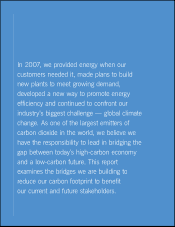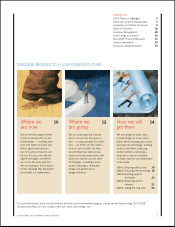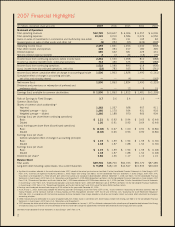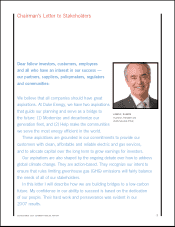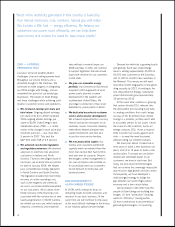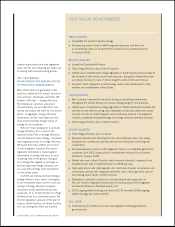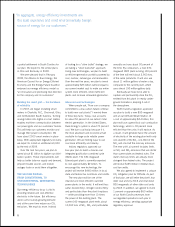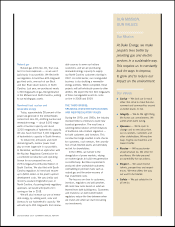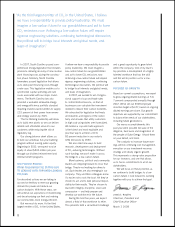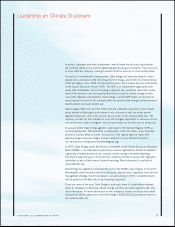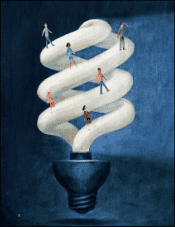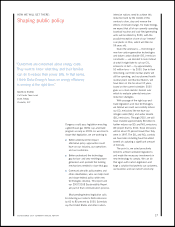Duke Energy 2007 Annual Report Download - page 9
Download and view the complete annual report
Please find page 9 of the 2007 Duke Energy annual report below. You can navigate through the pages in the report by either clicking on the pages listed below, or by using the keyword search tool below to find specific information within the annual report.
DUKE ENERGY 2007 SUMMARY ANNUAL REPORT 7
OUR MISSION,
OUR VALUES
Our Mission
At Duke Energy, we make
people’s lives better by
providing gas and electric
services in a sustainable way.
This requires us to constantly
look for ways to improve,
to grow and to reduce our
impact on the environment.
Our Values
Caring — We look out for each
other. We strive to make the envi-
ronment and communities around
us better places to live.
Integrity — We do the right thing.
We honor our commitments. We
admit when we’re wrong.
Openness — We’re open to
change and to new ideas from
our co-workers, customers and
other stakeholders. We explore
ways to grow our business and
make it better.
Passion — We’re passionate
about what we do. We strive for
excellence. We take personal
accountability for our actions.
Respect — We value diverse
talents, perspectives and experi-
ences. We treat others the way
we want to be treated.
Safety — We put safety first in
all we do.
■
■
■
■
■
■
Natural gas
Natural gas emits less CO2 than coal,
but it is more expensive — so we use it
judiciously in our portfolio. We filed with
our regulators to build two 620-megawatt
gas-fired units, one each at our Buck
and Dan River steam stations in North
Carolina. Last year, we purchased nearly
1,300 megawatts of gas-fired generation
in the Midwest and North Carolina, adding
to our existing gas assets.
Non-fossil fuel: nuclear and
renewable energy
Today, approximately 28 percent of the
power we generate in the United States
comes from zero CO2-emitting nuclear and
renewable energy — about 5,000 mega-
watts of nuclear capacity and about
3,200 megawatts of hydroelectric capacity.
We also have more than 3,100 megawatts
of hydroelectric capacity in South America.
To reduce CO2 emissions and meet
demand growth, nuclear power must
play an even larger role in our portfolio.
In December, we filed an application with
the Nuclear Regulatory Commission for
a combined construction and operating
license for our proposed two-unit,
2,234-megawatt Lee Nuclear Station in
South Carolina. We also filed with South
Carolina regulators to invest and recover
up to $230 million in the plant’s upfront
development costs. We saw similar cost
recovery assurance legislation pass in
North Carolina. Assuming timely regulatory
approvals, we would anticipate unit 1
coming on line in 2018.
We will also increase our use of renew-
able energy, by adding wind, solar and
biomass to our hydroelectric capacity. We
will add up to 200 megawatts from renew-
able sources to serve our Indiana
customers, and we are purchasing
renewable energy capacity to supply
our North Carolina customers starting in
2012. As noted earlier, our nonregulated
business is also building a renewable
energy portfolio. When completed, these
projects will sell wholesale power to other
utilities. We expect the first 240 megawatts
of these nonregulated assets to come
on line in 2008 and 2009.
THE THIRD BRIDGE:
SPANNING INVESTOR EXPECTATIONS
AND NEW REGULATORY RULES
During the 1970s and 1980s, the industry
invested trillions of dollars to build new
baseload generation. The result was a
sobering demonstration of the limitations
of traditional rate-of-return regulation —
for both customers and investors. This
construction binge resulted in rate shocks
for customers, cost overruns, the cancella-
tion of half-finished plants and ultimately
red ink for shareholders.
In the 1990s, we turned to the
deregulation of power markets, relying
on market signals to build new generation
cost-effectively. But these experiments
produced other undesirable outcomes:
overbuilding in premium fuels such as
natural gas and the under-recovery of
true investment costs.
The lessons are clear to customers,
investors, regulators and policymakers.
We need new rules based on what we
learned from both building eras. Customers
and investors can both benefit when
regulators reduce the time between when
we invest and when we start recovering
our investments.


